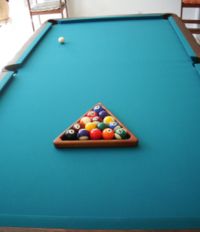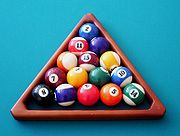.gif)
Cribbage (pool)
Encyclopedia

Pocket billiards
Pool, also more formally known as pocket billiards or pool billiards , is the family of cue sports and games played on a pool table having six receptacles called pockets along the , into which balls are deposited as the main goal of play. Popular versions include eight-ball and nine-ball...
game that, like its namesake card game
Cribbage
Cribbage, or crib, is a card game traditionally for two players, but commonly played with three, four or more, that involves playing and grouping cards in combinations which gain points...
, has a scoring system which awards points for pairing groups of balls (rather than playing cards) that total 15. Played on a standard pool table, participants who a ball of a particular number are required to immediately pocket the companion ball that tallies to 15 when added to the prior ball's number. The goal is to score 5 paired cribbages out of a possible 8, with the exception that the last ball, required to be the 15 ball, is not paired but alone counts as 1 cribbage.
Set-up
At the start of cribbage, a standard set of fifteen pool balls are rackedRack (billiards)
A rack is the name given to a frame used to organize billiard balls at the beginning of a game. Rack may also be used as a verb to describe the act of setting billiard balls in starting position in billiards games that make use of racks , as well as a noun to describe the balls in that starting...
at the end of a pool table, with the of the rack centered over the and the 15 ball placed at the rack's center. All other balls are placed randomly except that no two of the three corner balls may total to fifteen. Such an open-ended racking rule is unusual in that most pool games require particular balls to be placed at the corners of the rack and sometimes in fixed positions inside the rack as well. The arrangement thus results in 134,120,448,000 possible racking patterns (14 × 12 × 10 × 2 × 11!
Factorial
In mathematics, the factorial of a non-negative integer n, denoted by n!, is the product of all positive integers less than or equal to n...
).

Straight Pool
Straight pool, also called 14.1 continuous or simply 14.1, is a pocket billiards game, and was the common sport of championship competition until overtaken by faster-playing games like nine-ball...
and one-pocket). The object of the game is to score 5 cribbages out of a possible 8 in a full rack of 15 balls.
Cribbages
A cribbage is a pair of numbered balls which, when added together, total to 15 points. A cribbage only lies where the two partner balls forming the cribbage are each legally made, i.e., where no is committed on the same strokes that pocket the balls, or the shot is otherwise deemed illegal. The one exception to pairing is the 15 ball, which itself becomes a cribbage but only once all other of the rack have been pocketed. Thus, not including the 15 ball, the available cribbages are the 1-14, 2-13, 3-12, 4-11, 5-10, 6-9 and 7-8.Rules of play
A cribbage only counts when the paired balls are pocketed in succession in the same . Where a player pockets a first paired ball and is thus on a cribbage, if the companion ball is not pocketed on the next stroke, the shot is a foul and the unpaired balls of any cribbages not completed are to the . If the foot spot is occupied, balls are spotted as close as possible to the foot spot on the stretching back from the foot spot to the .The penalty for all fouls is the ending of the player's inning; no points are lost, and the incoming player has the option of shooting from position or taking from the (behind the table's ). In older rules a foul was a loss of one point. Three successive fouls in cribbage is a loss of game. Pocketing the 15 ball when it is not the last ball on the table is not a foul. Instead it is immediately spotted and play continues without penalty.
When players pocket more than one ball on a single at any time, a situation often arising on the , they may shoot at any companion balls, but must pocket each in succession in any order. If incidental balls are pocketed on the same stroke that a cribbage is completed, they add to the succession of cribbages the player is "on". When a player fouls by failing to pocket an unpaired cribbage while on a succession of unpaired balls, only unpaired balls are spotted; the prior successful cribbages count toward the score.
Normal ball and rail foul rules apply in cribbage. This is a requirement present in most pool games that a player must contact an with the cue ball and after that contact, either pocket an object ball, or some ball including the cue ball must contact a rail. When a foul results from the cue ball into a pocket or jumping it off the table, the player has cue ball in hand from the kitchen. When a player has cue ball in hand from the kitchen and all object balls are also behind the head string in the , a player has the option of having the object ball nearest the head string relocated to the foot spot. If in this situation two or more object balls are equidistantly closest to the head string, the player may designate which ball is to be relocated.

